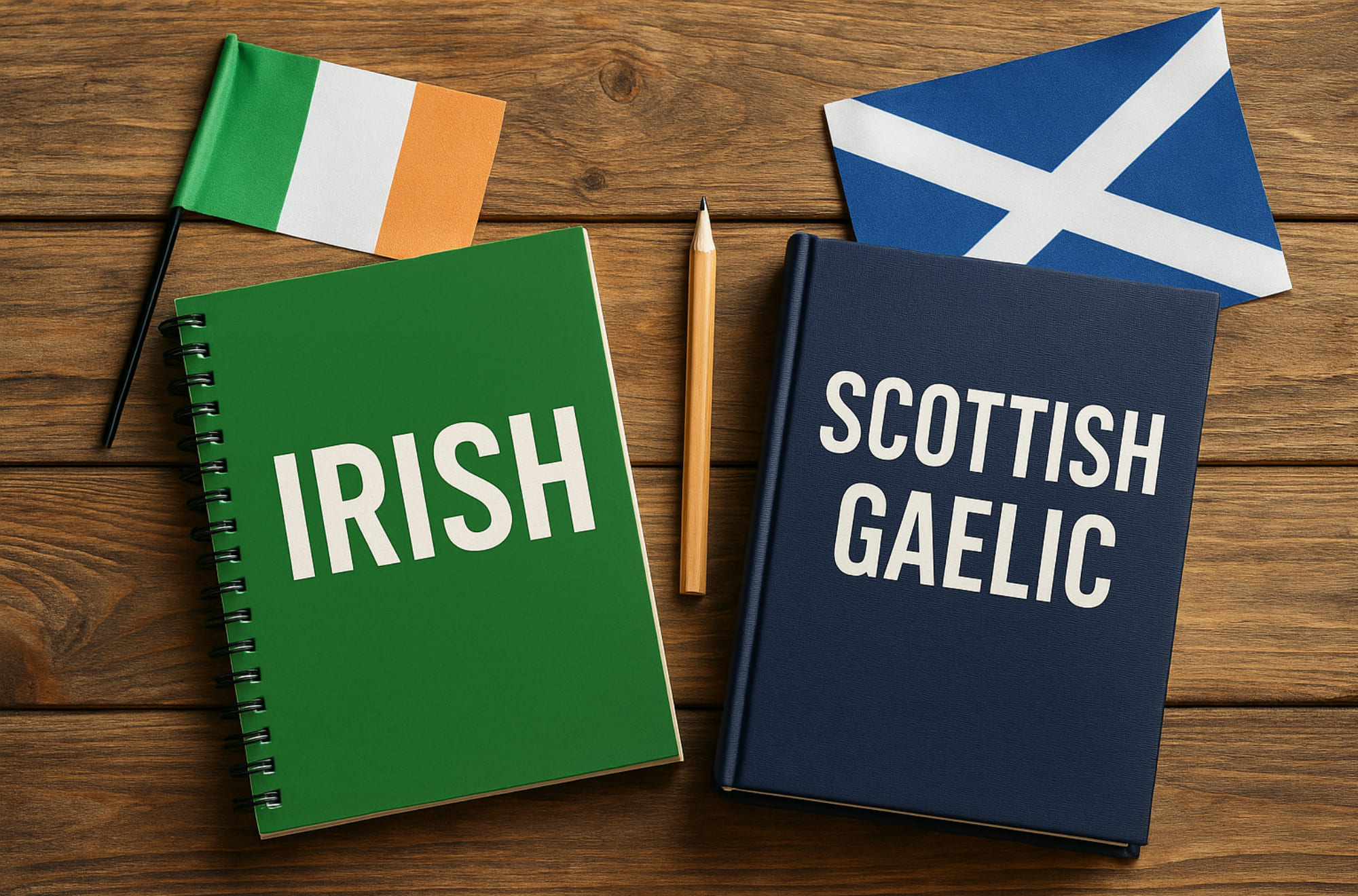If you’ve ever wondered about Irish vs Scottish Gaelic, you’re not alone. While both languages are extremely closely related, each has its own history, features, and cultural significance. Whether you’re researching your ancestry, planning a trip, or you’re simply curious, understanding the comparison of Irish and Scottish Gaelic opens up to rich linguistic heritage and present-day revival initiatives.
In this post, we’ll summarize the main differences—and parallels—between Scottish Gaelic and Irish Gaelic, so you can more easily see their position in heritage, identity, and modern-day learning.
History of the Languages
Irish language history dates back over 2,000 years, making it one of the oldest written languages in Europe. It evolved from Primitive Irish, seen in ancient Ogham inscriptions, into Old Irish, Middle Irish, and then modern Irish (Gaeilge). Scottish Gaelic diverged from Irish around the 5th century, brought to Scotland by Irish settlers.
Over time, both languages were deeply impacted by colonial history, with English dominance pushing them to the margins. Yet both have persisted—thanks to language activists and community-led revival efforts. Explore more in our History of Learning Gaeilge.
Language Learning Resources
If you’re ready to dive into learning Irish or Scottish Gaelic, you’re in luck—today’s resources are better than ever.
- 📚 Start with our Online Irish Language Courses for engaging, bite-sized lessons.
- 🎧 Practice pronunciation with our Irish Pronunciation Guide.
- 💬 Prefer one-on-one help? Find support through our Guide to Finding an Irish Tutor.
Both languages offer vibrant digital communities, flashcards, podcasts, and beginner-friendly tools to keep learners motivated.
Pronunciation and Vocabulary Challenges
Both Irish and Scottish Gaelic have sounds unfamiliar to English speakers. For instance, slender consonants and broad vowels take practice to master.
- In Irish, words like mh or bh are often pronounced like a v or w.
- In Scottish Gaelic, stress almost always falls on the first syllable, which can trip up beginners.
Use our Irish Pronunciation Guide and Vocabulary Expansion Tips to build fluency, especially when tackling adjectives and verbs.
Grammar and Syntax Differences
Although both languages come from the Goidelic family, their grammar and dialects show clear distinctions:
| Feature | Irish Gaelic | Scottish Gaelic |
|---|---|---|
| Word Order | Verb–Subject–Object | Same, but with variation |
| Future Tense | More regular | Less consistent |
| Dialects | Connacht, Munster, Ulster | Highland, Hebridean |
Explore more in our Comparison of Irish and Scottish Gaelic Grammar and Mastering the Future Tense in Irish.
Cultural Significance
Language is never just about words—it’s about culture. Both Irish and Scottish Gaelic are rich in folklore, sayings, and traditional values.
- Irish proverbs (Seanfhocail) offer timeless wisdom. Dive into them in our guide to Exploring Seanfhocail.
- Greetings in Irish (Dia duit, Slán) reflect deeply rooted traditions. Learn the most common Irish Language Greetings and Phrases.
Understanding these cultural contexts makes your learning journey more meaningful—and memorable.
Practical Use in Real Life
You don’t need to be fluent to use Irish or Scottish Gaelic in real life. Here are a few simple ways:
- Conversations: Use greetings, introductions, and thank-yous from our Basic Irish Conversation Guide.
- Counting and Directions: Learn to Count People in Irish or ask “Where is the bus?”—all helpful on your travels.
- Daily Use: Integrate phrases into your routine with our Daily Irish Practice Plan.
Conclusion: Why Irish vs Scottish Gaelic Still Matters
Understanding Irish vs Scottish Gaelic is more than a linguistic exercise—it’s about connecting with two vibrant, living cultures that have endured centuries of change. By appreciating their unique identities and shared roots, you become part of a growing movement of learners and heritage seekers.
Ready to start learning?
👉 Start your free trial with Gaeilgeoir AI and explore the beauty of Irish and Scottish Gaelic today.
Related Resources
Comparison of Irish and Scottish Gaelic Grammar


